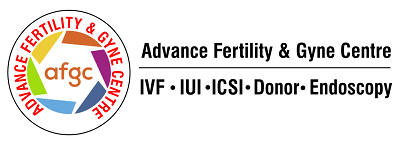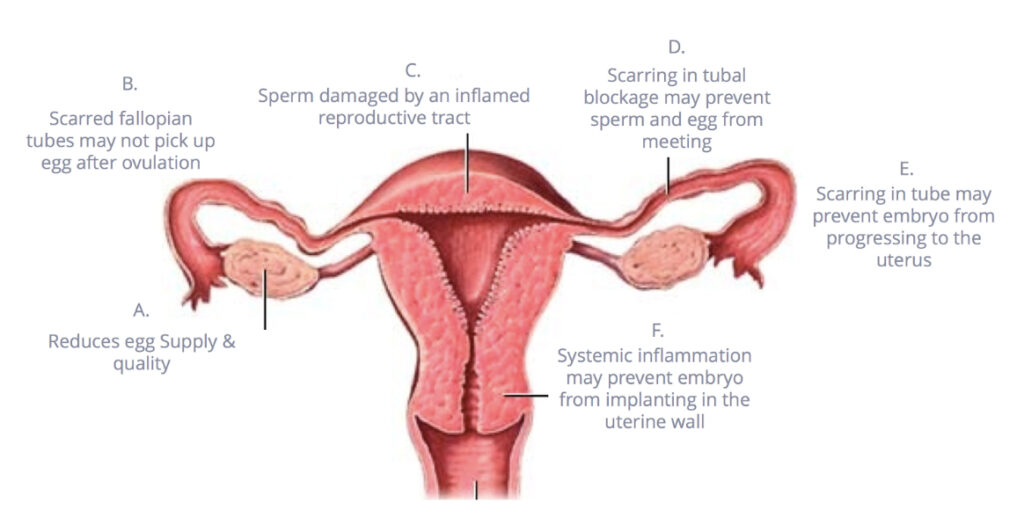When the uterine lining tissue grows in the ovaries or anywhere outside the uterus, it can lead to a condition called endometriosis. This condition disrupts normal pelvic function and can cause significant pain.
Women aged 15 to 44 are at a higher risk because, during this time, their bodies are undergoing regular menstrual cycles, which can exacerbate the spread and symptoms of endometriosis. The condition can cause painful periods with excessive bleeding, among other symptoms such as pelvic pain, fatigue, and bloating. Failing to address the causes of endometriosis can cause dyspareunia (pain during intercourse), pain with urination or bowel movements, and infertility. This is why it’s important to see a gynaecologist.
What are the causes of endometriosis?
The causes of endometriosis are complex and not fully understood, but it involves the growth of uterine lining tissue outside the uterus—such as in the pelvic cavity, fallopian tubes, bladder, and intestines. This ectopic tissue growth is thought to be influenced by hormonal fluctuations and immune system dysfunctions, creating an environment where these cells can thrive outside their usual location.
This condition arises when this tissue, instead of being expelled during menstruation, becomes trapped, leading to inflammation and the formation of painful lesions, adhesions, and cysts. These growths can cause significant discomfort and pain as they respond to hormonal changes in the body. The inflammatory response triggered by the trapped tissue can also lead to the release of pain-inducing chemicals and promote further adhesion formation, exacerbating the condition.
Specifically, when endometriosis affects the ovaries, it can interfere with egg quality and lead to complications such as blocked fallopian tubes and altered pelvic anatomy. This can result in the formation of tubo-ovarian masses that potentially affect the immune system and make it harder for sperm to reach the egg or for an embryo to implant in the uterus, thus complicating efforts to conceive. These reproductive challenges highlight the importance of early diagnosis and treatment for those with endometriosis wishing to get pregnant.
The exact triggers of endometriosis are still being researched, but potential factors include:
Genetics –
Endometriosis may run in families. Heritability (genetic factors) may play a role in its development in some women.
Lifestyle choices –
Diet, exercise, and substance use may influence the risk of developing endometriosis. For example, high oestrogen levels, which can be affected by certain foods and body fat percentage, may exacerbate the condition. Avoiding excessive alcohol consumption and smoking may also reduce risk factors.
Hormonal imbalances –
Imbalances in oestrogen and other hormones may encourage the growth of endometrial tissue outside the uterus. Researchers are exploring how these imbalances contribute to the onset and progression of endometriosis.
The aftermath of abdominal surgeries – Surgeries may leave behind scar tissue that contributes to the development of the condition. This scar tissue can create physical environments that support the implantation and growth of ectopic endometrial cells, further complicating the internal landscape of the pelvic region.
What is the treatment for endometriosis?
While there is no treatment for endometriosis, its symptoms can be managed medically. Gynaecologists with the right training and expertise can address the cause and prevent further complications. These experts can address all types of this condition, including:
Superficial endometriosis –
When the uterine lining tissue is superficially present on organs
Deep endometriosis –
When the uterine lining tissue invades organs outside or within the pelvic cavity, resulting in masses and lumps that stick together to immobilise the pelvis
Endometriomas –
When the uterine lining tissue is inside the ovary and creates a chocolate cyst.
At Advance Fertility, the approach to managing the causes of endometriosis primarily focuses on alleviating the pain caused by this condition. Our specialists provide options to enhance fertility and minimise discomfort.
Surgical intervention may be advised as a treatment for endometriosis for mild cases, which can also aid in improving fertility chances. For managing pain, our physicians might suggest reliable pain management medications, hormone therapies to halt the menstrual cycle or laparoscopic procedures.
Do you suffer from this condition?
Endometriosis can manifest in various ways beyond painful periods and intercourse. Gynaecologists also investigate symptoms like constipation, nausea, bloating, diarrhoea, rectal bleeding, and fatigue, particularly during menstrual periods. A key goal in treatment for endometriosis is to alleviate these distressing symptoms.
Currently, surgical intervention in the form of laparoscopy is only the definitive method for diagnosing endometriosis. During laparoscopy:
- The abdomen is gently inflated with a safe gas by the surgeon using a special instrument.
- A small incision is made in the abdomen, through which a laparoscope (a slender instrument equipped with a light and camera) is inserted to examine the reproductive organs, intestines, and other areas for endometriosis.
- If endometrial-like tissue is found, the surgeon assesses it to confirm whether it’s endometriosis and determine its stage.
- A biopsy may be conducted in certain instances, where a small sample of the tissue is collected for microscopic examination to verify the diagnosis.
While laparoscopy is common, a laparotomy (which involves a larger cut) may sometimes be necessary for diagnosis.
Imaging techniques, such as ultrasound and magnetic resonance imaging, are also used by healthcare providers to detect larger endometriosis formations like nodules or cysts. However, these methods cannot identify smaller lesions or adhesions.
Laparoscopy is considered after a thorough review of the patient’s medical history and a comprehensive physical and pelvic examination. This preparatory step, combined with ultrasound or MRI findings, aids in making well-informed treatment decisions.
If you’re encountering any of these signs, it’s crucial to consult with a specialist. Dr. Kaberi Banerjee at Advance Fertility & Gynecology Centre in India offers expert treatment for endometriosis. She is dedicated to identifying the underlying causes of your symptoms to prevent serious complications such as infertility. To seek her professional care, you can easily book an appointment online or reach out by calling +91-9871250235.


